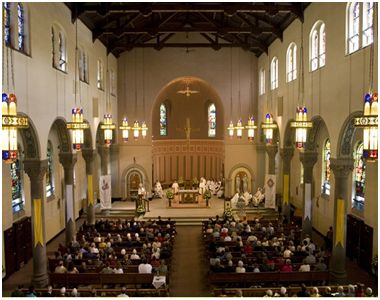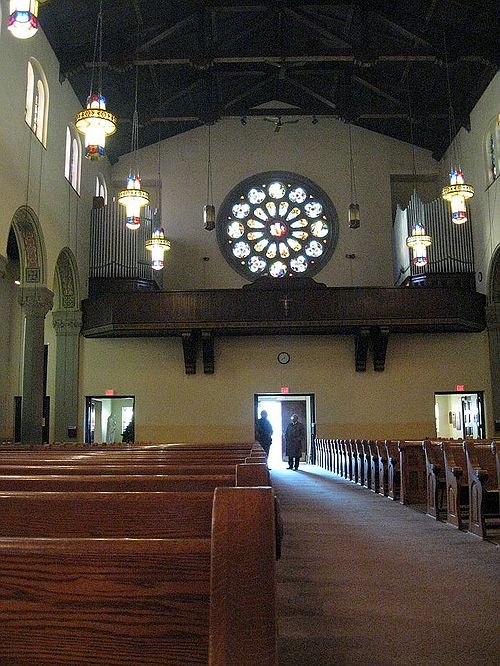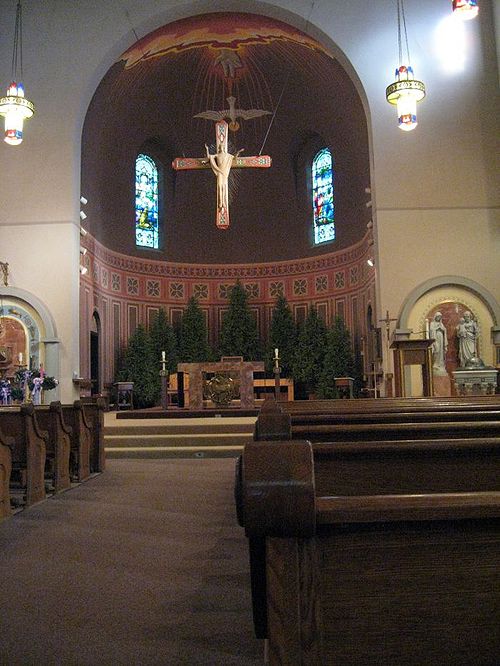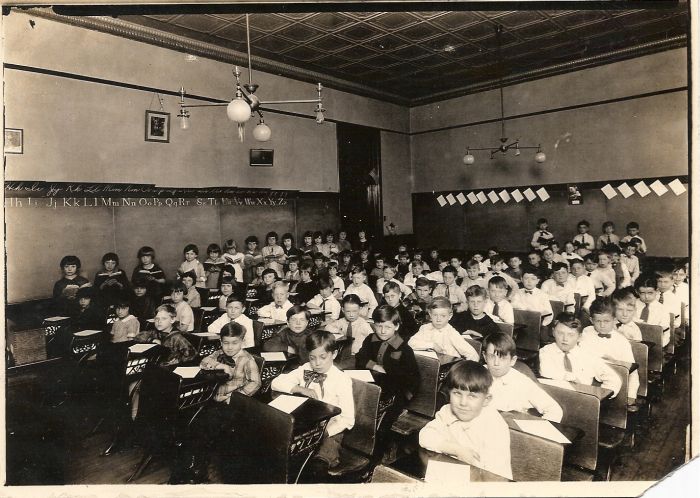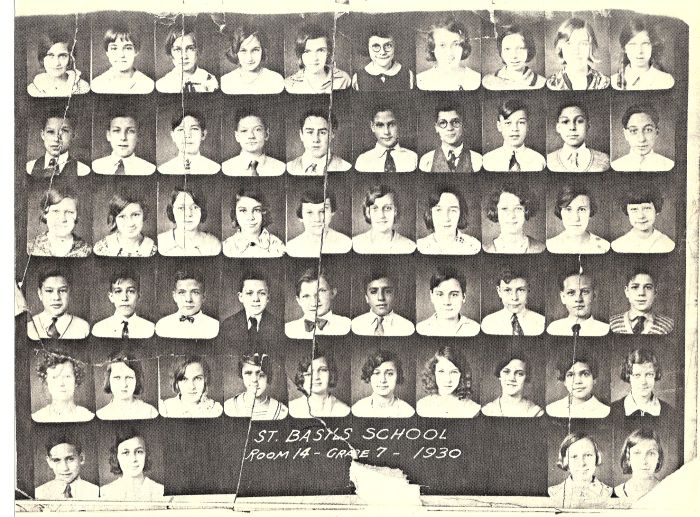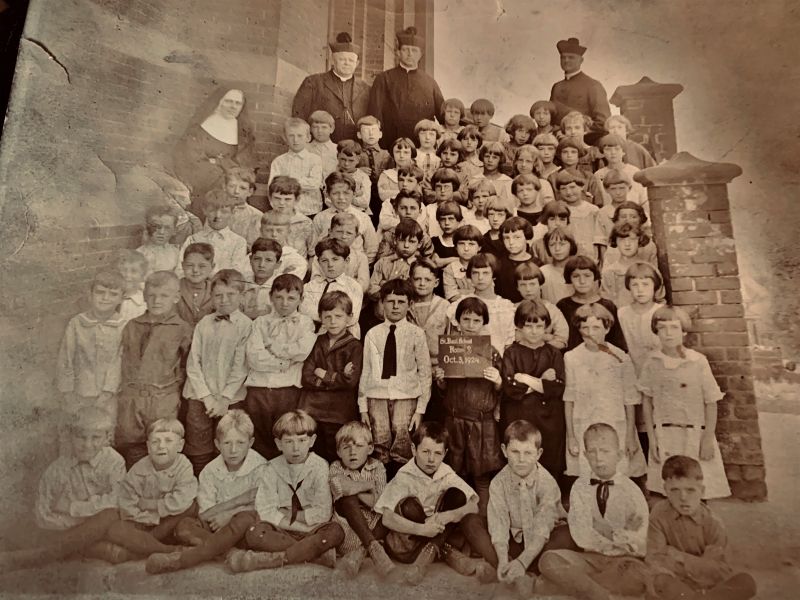St. Basil’s School and Church
Contents
- 1 Roman Catholic, 1735 Brownsville Rd, Pittsburgh, PA 15210. Originally located on Cherryhill Street currently the site of the Pittsburgh Public School, Roosevelt School. Church was built at the current location in 1907. St. Basil's Elementary School occupied that building prior to extensive remodeling.
- 2 Can you identify these kids?
- 3 St. Basil's School 1st Grade Class, 1926
- 4 St. Basil's School 7th Grade Class photo 1930, Room 14
- 5 Maureen Davis submitted this photo with this message.
- 6 My dad’s family, the Bernardings, grew up on Westmont Ave in Carrick and I would like to contribute a photo from a class at St Basils 1924. And also would like my uncle, Archbishop George E. Bernarding, who was a missionary to New Guinea beginning in the late 1930s, added to the Peoples Section. He also went to St. Basils.
- 7 St. Basil School Room 2 1924
Roman Catholic, 1735 Brownsville Rd, Pittsburgh, PA 15210. Originally located on Cherryhill Street currently the site of the Pittsburgh Public School, Roosevelt School. Church was built at the current location in 1907. St. Basil's Elementary School occupied that building prior to extensive remodeling.
From the 2011 Advent Historic Church Walk Booklet
St Basil Roman Catholic Church
1735 Brownsville Road
Pittsburgh PA 15210
Saint Basil Parish in Carrick celebrated the 100th anniversary of its founding on February 14, 2007.
Saint Basil Parish was founded when a small group of families from Carrick petitioned the Bishop of Pittsburgh in 1906 to form a new parish. Until that time, St. Wendelin Church, located in eastern Carrick, was the only Catholic parish in the area, and it was a considerable distance to travel for the many people living along Brownville Road.
In March 1907, some land was acquired at the corner of West Cherryhill Street and Brownsville Road, and early plans were drawn up for the construction of a large red, rectangular, combination church and school building. The architect was Thomas Comes, one of Pittsburgh’s greatest architects.
In 1922, to accommodate the ever-growing congregation, Father Charles J. Steppling proceeded with the construction of the present church on the same piece of property as the parish house, just a little to the right of it, at 1725 Brownsville Road. The Pittsburgh Catholic newspaper gave the following description of the new church:
The new church takes its place as one of the purest types of basilica in this state. With walls of brick and stone, the floor is of mosaic, with a center aisle in cork. The sanctuary is a deep and wide spacing in bordered mosaic of subdued tones to carry through the warm airy atmosphere of the gray limestone which makes the 14 great columns with Corinthian capitals dividing the nave on both sides and which in tone completes the whole interior.
The windows flood the church with a glorious array of color and fire by day and they are marvelously beautiful from the exterior by night. Father Steppling noted that the picturization and the designs were drawn and windows made in Holland.
In the sanctuary on the right side is the window of “The Sacrifice of Melchiesedech,” and on the left side is “The Lords’s Supper”. On the left wall of the nave are in succession The Sacred Heart, St. Basil, (patron of the church) St. Gregory Nazianzus, Christ Blessing the Children, The Annunciation, St. George, St. Francis Seraph, St. Benedict; on the right side The Holy Family, St. Ambrose, St. Augustine, St. Charles and St. Aloysius, Christ Giving the Keys to St. Peter, St. Henry, St. Joseph, St. Rose of Lima.
St. Basil Church is a brick construction of Byzantine architecture. The one tower that it possesses houses three bells which ring forth to remind all the faithful of the specific liturgical function that is to be enacted. The bells are named Saint Aloysius (from the first church) donated by Mr. Aloys Winter; Saint Charles (the largest bell) donated by Charles Lanz; and Saint Barbara donated by Barbara Winters. The bells are operated electronically from the sacristy.
The windows of the upper clerestory (the highest story of the nave of a church, with windows opening above the aisle roofs) are double, each pair being in the arch section between the pillars (the original cost of each window was $60). A large rose window showing Christ and the Four Evangelists (Matthew, Mark, Luke and John) adds to the beauty of the front of the church. See our booklet: Church Windows of St. Basil (located at the entrance of the church) for a fuller description.
Upon entering Saint Basil Church, you are greeted by two four-foot tall white marble angels, each holding a vessel of holy water. They were donated by Mr. and Mrs. Joseph Dieterle and Mr. Raymond Winters. Off the vestibule to the right, currently the candle shrine, was the site of the baptistry. The window in the baptistry depicts Christ being baptized by John in the Jordan River (donated by the Christian Mothers). The baptismal font is now located in the sanctuary to the right of the altar. The Sorrowful Mother in the shrine was also later donated by the Christian Mothers. The statue of Saint Basil in the niche outside the church (high above the front doors) was donated by Thomas McGovern.
Saint Basil Church stands unsurpassed for its beauty of style, originality of design, and fineness of workmanship. It remains the spiritual home of nearly 2,400 Catholic Christians in Carrick and the neighboring areas.
Can you identify these kids?
St. Basil's School 1st Grade Class, 1926
